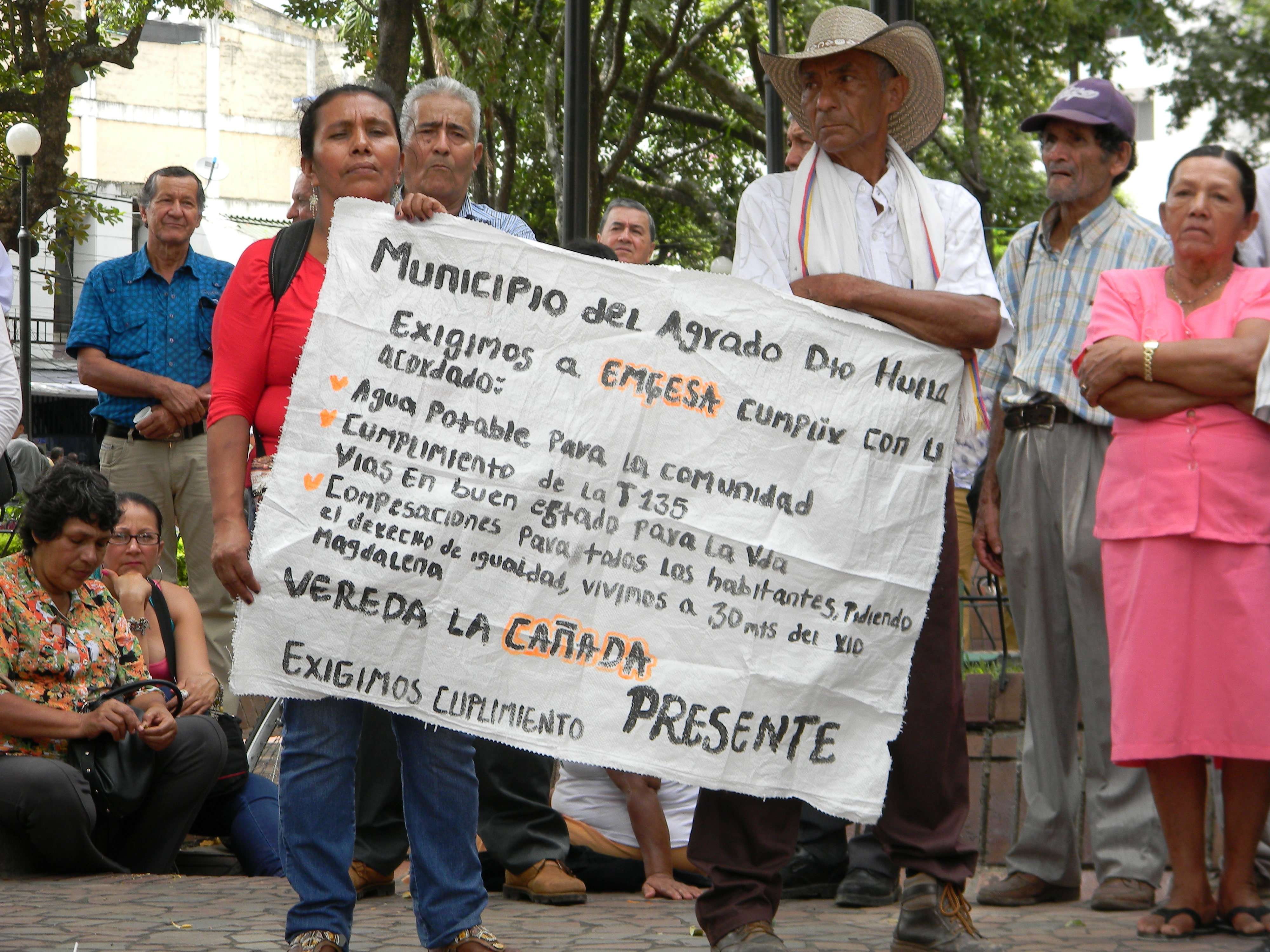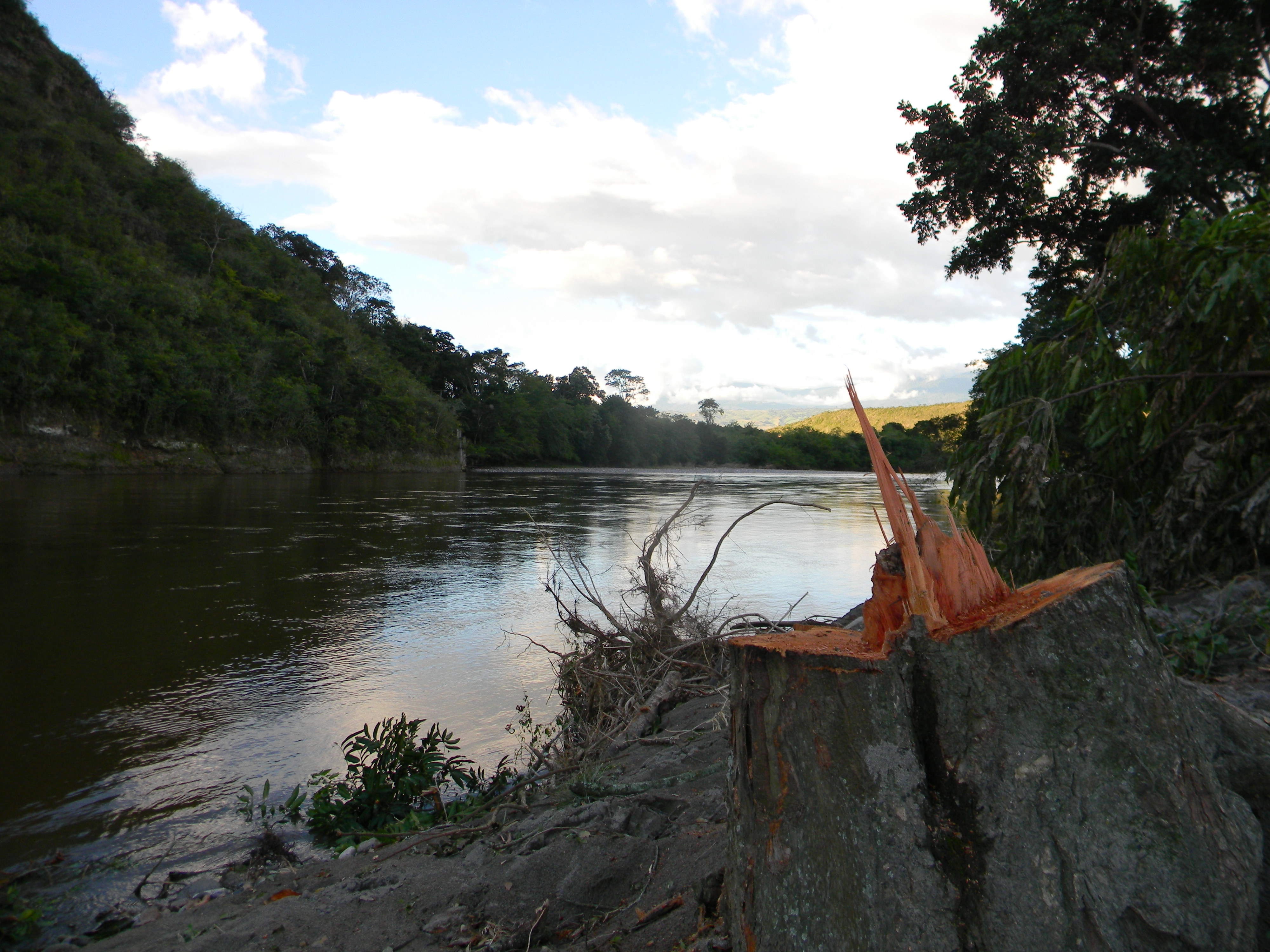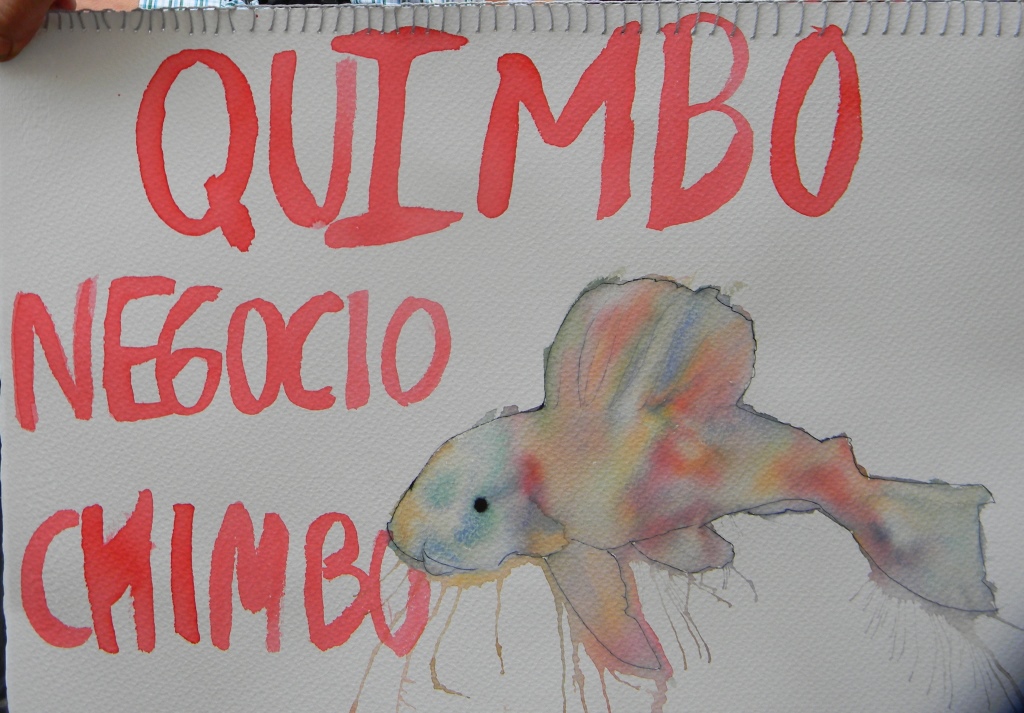
The threat of the Quimbo Hydroelectric Project at its final hour, the Huilense people stand once again in defense of the Yuma River and their territory
In what has been close to eight years of struggle for a territory, a free and dignified river, the communities affected by the Quimbo Hydroelectric Project in the center of the department of Huila, Colombia has reached its most critical point. The multinational company responsible for the hydroelectric project, Emgesa (Endesa-Enel), has only completed a portion of the environmental, social and infrastructure requirements that they are required to have completed prior to the filling of the dam’s reservoir which started at 5am on June 30th. Emgesa’s director Lucio Rubio told press the dam would be operational by September of this year and will be completely filled in its 8.500 Ha reservoir by early next year.
The communities that have organized and struggled for these years have done so as the Association of Affected Peoples of Quimbo Hydroelectric Project (ASOQUIMBO) and the Movement Ríos Vivos Colombia. Since the beginning when Uribe handing over nearly 10,000 Ha of land to a foreign company as “public utility” in 2008, every single aspect of the environmental license for the Quimbo Hydroelectric project has either been systematically ignored by the ANLA (National Authority of Environmental Licenses), or changed to favor the company´s needs disregarding the people, communities and the ecosystems. One of these cases is of the Ávila Family, the owners and caretakers of the property known as “Las Juntas” in La Jagua, who had their 16 Ha of land used for mixed crops and small scale dairy cattle that has supported the family for over eight decades. “We lost everything, this land is what has supported my family for generations and all we demanded was to relocated or compensated fairly as stated in the environmental license ¨ the same or better condition¨ and now the State expropriates us a forces us to accept less than half of the land´s worth” lamented Jose Ávila one of the brothers who herds cattle on the land.
 Mobilization ¡The River of Life!
Mobilization ¡The River of Life!
In March of this year ASOQUIMBO and Ríos Vivos in accompaniment of writer William Ospina organized and traveled the National Mobilization of the Defense of the Magdalena (Yuma) River, the territories, (The River of Life), a territorial journey following the Yuma River through its first bioregions, the Colombian Massif and the Upper Magdalena in the departments of Huila and Tolima, visiting the territories affected by the 17 dams that are intended to be built as part of the Master Advantage Plan of the Magdalena River. The beginning initiated in San Agustin passing through all the places where dams exist or are planned, Pitalito, Timana, La Jagua, Hobo, Neiva, Aipe, going throughout Tolima to Honda and finishing in Dorada (Caldas) with a ceremony in the river.
In the first part of journey following the river there were marches, forums, press conferences where all the aspects and threats related to the Master Advantage Plan of the Magdalena River, which the national government is putting into effect through the entity CORMAGDALENA in conjunction with the Chinese government´s state-owned company Hydrochina. The Master Advantage Plan seeks to turn the upper part of the river into a system of hydroelectric dams (the electricity is for industrial and not social needs) and from the middle to the lower region of the river it will be dredged to allow large container ships to be able to go up from the Caribbean Sea to Honda and connect with railways and highways to the pacific coast port of Buenaventura.
Master Advantage Plan of the Magdalena River
Just as the Quimbo H.P. has been built by consortiums and sub contracts, the group Navelena made up of the Brazilian company Odebrecht and the Colombian Valores and Contratos (Valorcon) will be in charge of the dredging and nagavenatility of the river. According to the magazine Portafolio, the dredging while have to allow for a width, depth, and curvature of a canal that allows container ships with up to 7,200 tons go up from Barranquilla to Barracabermeja; ships with 6,000 tons from Barracabermeja to Puerto Berrio, and ships with 800 tons from Puerto Berrio to Puerto Salgar. With those statistics that responsible entities aim to reach a fluid transport along the 652 kilometers from Barranquilla to Barrancabermeja. The goal is to surpass 1.2 million annual tons in 2014 to 6 million annual tons of our goods for exportation. The terms of the contract with Navelena are for 13.5 years at over 2 billion pesos. According to the National University of Colombia the aims of nagavibility for the river are unattainable do to the natural amount of sediments that the river has as well as the social and environmental impacts since the river.
The Plan also contemplates a cascade of hydroelectric dams starting in the Colombian Massif going all the way down to Honda: Guarapas, 140 MW & Chillurco 180 MW (both in Pitalito), Oporapa 220MW (in Oporapa), Pericongo 80 MW (in Timana), The Quimbo 400 MW (Central Huila), Betania 520 MW (built and functioning in Yaguara), The Manso 140 MW (in Neiva), Veraguas 130 MW (in Aipe), Bateas 140 MW (in Villavieja) and continuing into Tolima with the Basilias 140MW (in Natagaima), Carrasposo 170 MW & Nariño 200MW (in Girardot), Lame 560 MW (in Purificacion), Ambalema 160 MW (in Ambalema), Cambao 100 MW (in Cambao), Piedras Negras 100 MW and 3 more dams in Honda.
Ecocide in La Jagua and affected animals
In the community of La Jagua, the chainsaws in the hands of the workers of the subcontracted company Refocosta, has progressively deforested nearly all of the area that is projected to be inundated with the Quimbo Hydroelectric Project´s reservoir. Indiscriminately any plant with a trunk over 10 cm is taken down; the screams of the chainsaws have not stopped leaving a devastating landscape everywhere.
The massive deforestation which began in March of this year currently has finished in La Jagua. The first days there was resistance, but soon enough there were hundreds of loggers all over the thousands of hectares of land. What poorly organized forest defense was attempted was overwhelmed. What are left are people taking what wood has not been already taken, but everything is downed, and environmental authorities are harsh applying full force of the law on any one trying to salvage the wood that is rotting in the sun and rain. In La Jagua everything along the Magdalena River from the Juntas of the mouth of the Suaza River into the Magdalena River all the way up to the Peñalta farm. Refocosta has taken down all types of trees, destroying all sorts of dry tropical forest ecosystem from the Paso del Colegio in Gigante to La Virginia in Altamira, epic beings like the ceiba, iguá, cachimbo, raspa yuco, caracoli, dinde, bili bil and cedar lay strewn about on the ground, piled on top of each other flooding the landscape. The largest concentration is in the outskirts of Gigante as the machinery scramble to get as much wood out as they can now that the water is filling. None the less the Autonomous Environmental Corporation of the Upper Magdalena- CAM ordered the dam´s filling to be suspended due to the fact still over 20% of the biomass has not been logged from the reservoir area and what has been chopped down is piled up in the area, the ANLA ignored the CAM´s orders. Once filled, according to the Investigation Group of Limnology of the National University of Colombia has warned about the possible explosion of cyanobacteria in the reservoir of the Quimbo H.P.
With the exception of the first couple of days in La Jagua, the logging has not had any setbacks. According to the loggers who work for Refocosta the company sells the wood to the multinational company Cartones de Colombia and the big box store chain Home Center. Those who end up buying this wood are buying the massacred and stolen forests of Huila.
Since the logging took place in the areas of La Jagua known as San José, Las Peñas, el Alemán, Las Cuchas and Peñalta the grape growers and vineyards in llano de virgin have complained about the fruit bats that have migrated and are finishing off their crops. Most growers to deal with the increase in of bats have resulted in applying more pesticides or shooting the bats. The fruit eating and pollinating flying mammals lose their homes and food but also the parrots in the caves of las Peñas have nothing left to eat, the snakes are seen killed and smashed along the high way as the escape the chain saws and the wrath of the falling trees. There are stories of near the wall where the water has already flooded the iguanas, rabbit and quail are perched in the tree tops waiting to be rescued by Emgesa´s boatmen or drown in the rising waters. Emgesa does not recognize the animals as affected; perhaps it is because the animals do not know how to stand in line outside the office that they have been included on the census of the affected. Emgesa hires veterinarians to relocate animals that they find like snakes, turtles, baby birds, and abandoned pets, though not all have had the best luck, the displaced animals that have had to endure this destruction also included otters, fox, ocelot, armadillo and deer.
 A supposed progress
A supposed progress
The roads uphill between Garzón and Gigante are already in use, as is the new longest bridge in Colombia, measuring at 1.8 km is has no lighting at all, railing and a side walk on only one side, and the pavement cracked in less than a week after its opening. The Viaduct that connects Garzón with El Agrado floods with tourists on the weekends taking selfies.
On July 6th the last person was displaced from the reservoir’s basin area. In the year 2013 Constitutional Court ordered sentence T-135 obligating Emgesa to realize another census of the affected population in less the 6 months, the company failed to do so. Just one more example of how Emgesa has washed its hand of so many obligations stipulated in the environmental license and the ANLA has facilitated and been complicit in the destruction and ecocide of the territory.
Francisco Cabrera along with wife Angela Trujillo, their children, grandchildren, pets and farm animals are true symbols of resistance, for a long time they were the last family left in Veracruz. What was once a community rich in crops, tree, water, animals, people and life now lays desolate amongst dead and scattered trees, the rubble of demolished homes, and taken over by private, armed security guards and dogs. Until few days ago the Cabrera Trujillo family, along with the church of Vercruz and some 20 trees were the last outcrop of resistance. In the finals days massive amounts of birds of all varieties took refuge in and around his house now that this was all that was left of their habitat. “Don Francisco put a banana on a branch for the birds to eat, “they have always come here and I have always fed them, forever, where will they go now?”.
For eight years Mr. Francisco a fisherman has demanded the company comply with the environmental license to be relocated to a property in the “same or better condition” then where he was on, something the company has not been able to do and is offering money to wash so they do not have to meet this obligation. As the Cabrera Trujillo family loaded their possessions onto the moving trucked Doña Ángela “We use to live so good, there was good work and a lot of fish. It is just to say the fishing here used to be so good, we could live from this… And now there is nothing left, everyone is gone, everyone has been displaced. It really is awful what has happened to us all. ”
Currently Emgesa has relocated people to illegal resettlements that have no permits or environmental licenses. People were relocated into areas that according to the CAM are of unsuitable ground and some are even to close to the oil pipeline of the Emerald Energy petroleum company. Most settlements do not have clinics or schools and some even lack potable water and in the case of the community resettled in La Galda in the Municipality of el Agrado, at one point they were left for two weeks where the water truck did not bring them the most needed and vital liquid.
Since the beginning the affected communities and academic allies knew and were saying that this huge disaster of an ecocide called the Quimbo would happen, from its inception of its irregular approval, it was already know it would turn out bad. In May of this year ASOQUIMBO held a Public Audience in the main campus of the South Colombian University (USCO) in Neiva. At the Audience representatives from the governor’s office, the CAM and the professor, investigator and spokesperson of ASOQUIBMO Miller Dussán along with Cecilia Quimbayo, from the Comptroller´s Office of the Republic criticized harshly backed up with studies and proof of Emgesa´s but also ANLA´s irregularities and unfufilments of the QUIMBO H.P. According to Dussan, “the tectonic faults near the Quimbo´s wall that if something were to move the disaster would be worse than 54 Armeros” (referring to the volcanic eruption and resulting avalanche in 1985 that destroyed the town of Armero, killing more than 20,000 people).
In terms of arguments presented to the audience there is the lack of restitution of 5,300 Ha of agriculturally productive lands that the company and INCODER (Colombian Government Land ??) has to distribute to the affected population, the individual and collective resettlements without the adjusting the Basic Plan of Territorial Order -POT-, the destruction of 842 Ha of dry tropical forest, the ignoring and refusal to acknowledge the relocating and restoration of the San José de Belen Chapel of el Agrado, on June 10th president of the community Junta Luz Neldy Bravo with other community members effectively stopped two men working for the subcontractor “Bautista & Bautista” in an attempt to “move” items in the church including the statues, the bell, pictures and tiles that was not authorized by the Dioceses or the governor.
In addition to these arguments on May 11th there was a trembler of with a reading of 3.8 on the Richter scale in Gigante a few kilometers from the wall of the Quimbo H.P. not to mention the dyeing of fish in the Betania Dam down river due to the lack of necessary oxygen because of the reduced water flow for the dam´s filling.
Land isn’t to be sold, it is to be defended!
In early June fisher people from Yaguará, Campoalegre and Hobo started a peaceful protest along the national highway between Hobo and Gigante which escalated to them taking over city hall and chaining themselves shutting down the building. The families that depend on small scale fishing for their livelihood protest the dyeing off of fish in Betania that Emgesa denies and refuses to recognize them as affected by the Quimbo H.P. yet the rich business owners with floating cages for fish farming in Betania were recognized and paid by Emgesa.
The filling of the Quimbo Hydroelectric Project has already commenced and you can see the flooding in of reservoir from the highway. Even though the Administrative Tribunal of Huila ratified a suit filed by the fish farmers of Betania, the filling goes on. The governor like so many others in the Colombian media who were quiet these eight years that Emgesa trampled the communities and ecosystems of central Huila and did nothing but ignore and speak ill of the communities of that mobilized in defense of the territory, now all of the political class is in an uproar about the illegal filling of the Quimbo.
On July 6th, after nearly two years being violently evicted, ASOQUIMBO once again liberated lands in the struggle to establish a Peasant Farmer Reserve with the 5,300 Ha that have not been given to the affected communities. Over 50 peasant families recuperated some 200 Ha in the area called Llano de la Virgen. That same day ASOQUIMBO reached an agreement with the police and Emgesa to organize a meeting with INCODER to settle the land and census issue in five days or more land liberations will occur.
On Friday, July 10th, mobilizations occurred in Neiva in the Santander Park in front of the governor´s office and in Garzon in front of City Hall. In Neiva different theatrical actions took over the city´s central park and in Garzon a chalk-in was had on the street in front of city hall. In Los Angeles, California a group of Colombian women took over the Colombian Consulate with signs forcing the Colombian diaspora to what is going on in areas like Huila. On Saturday, July 11th occurred the last mass at the Chapel in San Jose de Belen bringing together over a thousand people from the region, the Dioceses of Garzon and the different regional Parishes.
The fisher folk and farmers affected by the Quimbo H.P. are on the move and using a variety of tactics to do what they can to protect their territory from the announced disaster. The Colombian government, the multinational and national corporations the plan to continue to impose dams and other projects of displacement and destruction can only expect a growing tide of resistance from the communities that each value and cherish more the true wealth and strength they their territories have given them for so many generations; the rivers, the air, the land, are not to be sold, they are to be defended.
